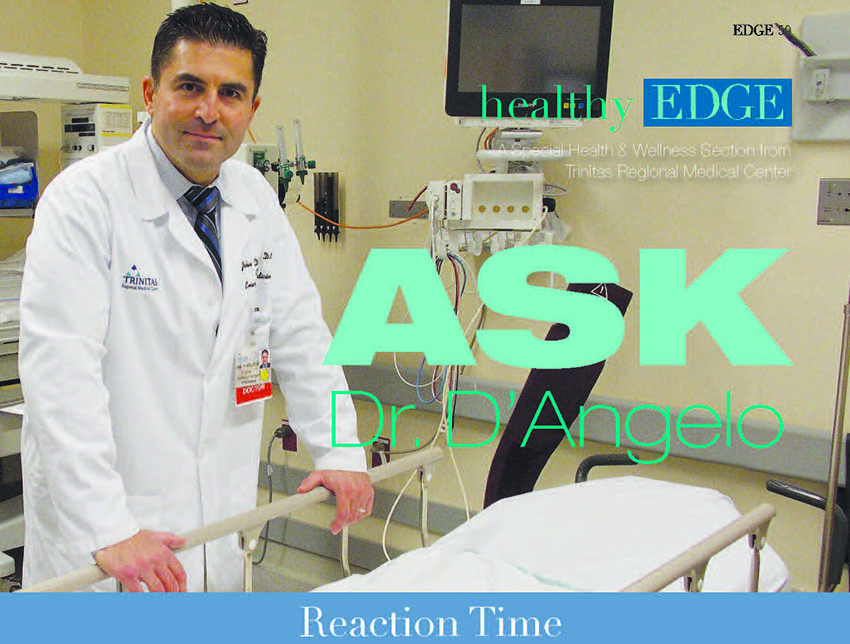Reaction Time
Allergies are the result of a reaction that starts in the immune system. An allergy to eggs, for instance, means your immune system identifies a protein found in eggs as an allergen. Your immune system reacts by producing antibodies called Immunoglobulin E (IgE). These antibodies attach to cells in your skin, lungs and gastrointestinal (GI) tract. If you come in contact with the allergen again, the cells release chemicals including histamine, which cause food allergy symptoms such as itching, hives, swelling, diarrhea, wheezing and a potentially life-threatening reaction called anaphylaxis. Without immediate treatment—an injection of epinephrine and expert care in a hospital—anaphylaxis can be fatal.

www.istockphoto.com
How do I identify anaphylaxis as opposed to an allergic reaction?
An allergic reaction is responsible for affecting one organ, as is the case with common dermatological manifestations like urticaria (hives) and pruritis (itching). The signs of an allergic reaction can begin with something as simple as a rash to something more severe, such as shortness of breath and difficulty breathing. Anaphylaxis involves the skin and additional organs. On the spectrum of allergic responses, anaphylaxis is a profound reaction.
When does an allergic reaction demand a visit to the ER?
When you suspect anaphylaxis. Symptoms may include difficulty breathing, dizziness or loss of consciousness. If you experience any of these symptoms in the context of eating, immediately call 911. If you have known food allergies and have been prescribed auto-injectable epinephrine, use it and then call 911. In either case, don’t wait to see if your symptoms go away or get better on their own.
What are the typical causes of profound allergic reactions?
In 2014, an article in the Journal of Allergy Clinical Immunology found that anaphylaxis in adult patients was triggered 34% of the time by medications, 31% by food, 20% by insect stings and environmental allergens, 2.6% by latex, 1.2% by exercise, and 11% by unknown factors. When you factor in children, food allergy has become the most common cause of anaphylaxis overall in the United States.
Safety Steps
A good day for me and my staff is a day when we don’t have to treat an anaphylaxis case. There are some basic steps you can take to help make that happen…
- Always ask about ingredients when eating at restaurants or when eating foods prepared by family or friends.
- Carefully read food labels. The United States and many other countries require that major food allergens (milk, egg, fish, shellfish, tree nuts, wheat, peanuts and soybeans) be listed in easy-to-understand language.
- If applicable, carry with you—and know how to use auto-injectable epinephrine and antihistamines to treat emergency reactions.
- Teach family members and other people close to you how to use auto-injectable epinephrine and consider wearing an ID bracelet that describes your allergy.
- If a reaction occurs, have someone take you to the emergency room, even if symptoms subside. Afterwards, get follow-up care from your allergist.
What percentage of children have food allergies?
Generally, food allergy in children has an estimated prevalence of 8% in the United States, with approximately 150 deaths per year. Common food allergens include eggs, milk, soy, peanuts, tree nuts and shellfish. Tree nuts and peanuts are responsible for a large proportion of anaphylactic reactions. All patients with food allergies should avoid contact with these products, including contact with areas where these foods are prepared.
Can kids “outgrow” an allergic reaction to a food, ingredient or spice?
Most children outgrow their allergies to cow’s milk, egg, soy and wheat, even if they have a history of a severe reaction. However, shellfish allergy tends to persist through adulthood. Repeat allergy testing with your allergist can help you learn if you or your child’s food allergies are resolving with time.
I’m lactose intolerant. Does that mean I’m allergic to milk?
There is a difference between food allergy and food intolerance. A food allergy involves the immune system while food intolerance—and lactose intolerance is a good example—does not. Food intolerance typically involves the GI tract, causing uncomfortable symptoms like abdominal pain, nausea, vomiting and diarrhea. But there is no risk of anaphylaxis.

www.istockphoto.com
Can stress trigger allergies?
When you’re all stressed out, your body releases hormones and other chemical— including histamine, that powerful chemical that leads to allergy symptoms. While stress doesn’t actually cause allergies, it can make an allergic reaction worse by increasing the amount of histamine in your bloodstream.
 Do you have a hot topic for Dr. D’Angelo and his Trinitas ER team?
Do you have a hot topic for Dr. D’Angelo and his Trinitas ER team?
Submit your questions to AskDrD@edgemagonline.com
Editor’s Note: John D’Angelo, DO, is the Chairman of Emergency Medicine at Trinitas Regional Medical Center. He has been instrumental in introducing key emergency medical protocols at Trinitas, including the life-saving Code STemi, which significantly reduces the amount of time it takes for cardiac patients to move from the emergency setting to the cardiac catheterization lab for treatment.





